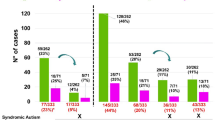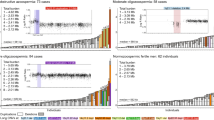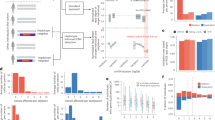Abstract
Although copy-number variations (CNVs) in Y-chromosomal azoospermia factor (AZF) regions have been associated with the risk of spermatogenic failure (SF), the precise frequency, genomic basis and clinical consequences of these CNVs remain unclear. Here we performed multiplex ligation-dependent probe amplification (MLPA) analysis of 56 Japanese SF patients and 65 control individuals. We compared the results of MLPA with those of conventional sequence-tagged site PCR analyses. Eleven simple and complex CNVs, including three hitherto unreported variations, were identified by MLPA. Seven of the 11 CNVs were undetectable by conventional analyses. CNVs were widely distributed in AZF regions and shared by ~60% of the patients and ~40% of the controls. Most breakpoints resided within locus-specific repeats. The majority of CNVs, including the most common gr/gr deletion, were identified in the patient and control groups at similar frequencies, whereas simple duplications were observed exclusively in the patient group. The results imply that AZF-linked CNVs are more frequent and heterogeneous than previously reported. Non-allelic homologous recombination likely underlies these CNVs. Our data confirm the functional neutrality of the gr/gr deletion in the Japanese population. We also found a possible association between AZF-linked simple duplications and SF, which needs to be evaluated in future studies.
Similar content being viewed by others
Log in or create a free account to read this content
Gain free access to this article, as well as selected content from this journal and more on nature.com
or
References
Vogt, P. H ., Edelmann, A ., Kirsch, S ., Henegariu, O ., Hirschmann, P . & Kiesewetter, F . et al. Human Y chromosome azoospermia factors (AZF) mapped to different subregions in Yq11. Hum. Mol. Genet. 5, 933–943 (1996).
Giacco, D. L ., Chianese, C ., Sanchez-Curbelo, J ., Bassas, L ., Ruiz, P ., Rajmil, O . et al. Clinical relevance of Y-linked CNV screening in male infertility: new insights based on the 8-year experience of a diagnostic genetic laboratory. Eur. J. Hum. Genet. 22, 754–761 (2014).
Repping, S ., Skaletsky, H ., Lange, J ., Silber, S ., Veen, F ., Oates, R. D . et al. Recombination between palindromes P5 and P1 on the human Y chromosome causes massive deletions and spermatogenic failure. Am. J. Hum. Genet. 71, 906–922 (2002).
Kuroda-Kawaguchi, T ., Skaletsky, H ., Brown, L. G ., Minx, P. J ., Cordum, H. S ., Waterston, R. H . et al. The AZFc region of the Y chromosome features massive palindromes and uniform recurrent deletions in infertile men. Nat. Genet. 29, 279–286 (2001).
Lu, C ., Jiang, J ., Zhang, R ., Wang, Y ., Xu, M ., Qin, Y . et al. Gene copy number alterations in the azoospermia-associated AZFc region and their effect on spermatogenic impairment. Mol. Hum. Reprod. 20, 836–843 (2014).
Shen, Y ., Yan, Y ., Liu, Y ., Zhang, S ., Yang, D ., Zhang, P . et al. A significant effect of the TSPY1 copy number on spermatogenesis efficiency and the phenotypic expression of the gr/gr deletion. Hum. Mol. Genet. 22, 1679–1695 (2013).
Stahl, P. S ., Mielnik, A. N ., Barbieri, C. E ., Schlegel, P. N . & Paduch, D. A . Deletion or underexpression of they-chromosome genes CDY2 and HSFY is associated with maturation arrest in American men with nonobstructive azoospermia. Asian J. Androl. 14, 676–682 (2012).
Kleiman, S. E ., Yogev, L ., Hauser, R ., Botchan, A ., Maymon, B. B ., Schreiber, L . et al. Members of the CDY family have different expression patterns: CDY1 transcripts have the best correlation with complete spermatogenesis. Hum. Genet. 113, 486–492 (2003).
Krausz, C ., Hoefsloot, L ., Simoni, M . & Tuttelmann, F . EAA/EMQN best practice guidelines for molecular diagnosis of Y-chromosomal microdeletions: state-of-the-art 2013. Andrology 2, 5–19 (2014).
Rosen, S. G ., Marszalek, J. D ., Irenze, K ., Skaletsky, H ., Brown, L. G . & Oates, R. D . et al. AZFc deletions and spermatogenic failure: a population-based survey of 20,000 Y chromosomes. Am. J. Hum. Genet. 91, 890–896 (2012).
Carvalho, C. M. B ., Zuccherato, L. W ., Fujisawa, M ., Shirakawa, T ., Ribeiro-dos-Santos, A. K. C ., Santos, S. E. B . et al. Study of AZFc partial deletion gr/gr in firtile and infertile Japanese males. J. Hum. Genet. 51, 794–799 (2006).
Repping, S ., Skaletsky, H ., Brown, L ., Daalen, S. K. M ., Korver, C. M ., Pyntikova, T . et al. Polymorphism for a 1.6-Mb deletion of the human Y chromosome persists through balance between recurrent mutation and haploid selection. Nat. Genet. 35, 247–251 (2003).
Fernandes, S ., Paracchini, S ., Meyer, L. H ., Floridia, G ., Tyler-Smith, C . & Vogt, P. H . A large AZFc deletion removes DAZ3/DAZ4 and nearby genes from men in Y haplogroup N. Am. J. Hum. Genet. 74, 180–187 (2004).
Lu, C ., Zhang, F ., Yang, H ., Xu, M ., Du, G ., Wu, W . et al. Additional genomic duplications in AZFc underlie the b2/b3 deletion-associated risk of spermatogenic impairment in Han Chinese population. Hum. Mol. Genet. 20, 4411–4421 (2011).
Krausz, C ., Giachini, C ., Xue, Y ., O’Brya, M. K ., Gromoll, J ., Meyts, E. R . et al. Phenotypic variation within European carriers of the Y-chromosomal gr/gr deletion is independent of Y-chromosomal background. J. Med. Genet. 46, 21–31 (2009).
Lin, Y ., Hsu, L. C ., Kuo, P ., Huang, W. J ., Chiang, H ., Yeh, S . et al. Partial duplication at AZFc on the Y chromosome is a risk factor for impaired spermatogenesis in Han Chinese in Taiwan. Hum. Mutat. 28, 486–494 (2007).
Ye, J ., Ma, L ., Yang, L ., Wang, J ., Wang, Y ., Guo, H . et al. Partial AZFc duplications not deletions are associated with male infertility in the Yi population of Yunnan Province, China. J. Zhejiang Univ. Sci. B 14, 807–815 (2013).
Giachini, C ., Laface, I ., Guarducci, E ., Balercia, G ., Forti, G . & Krausz, C . Partial AZFc deletions and duplications: clinical correlates in the Italian population. Hum. Genet. 124, 399–410 (2008).
Stuppia, L ., Antonucci, I ., Palka, G . & Gatta, V . Use of the MLPA assay in the molecular diagnosis of gene copy number alterations in human genetic diseases. Int. J. Mol. Sci. 13, 3245–3276 (2012).
Coughlin, C. R ., Scharer, G. H . & Shaikh, T. H . Clinical impact of copy number variation analysis using high-resolution microarray technologies: advantages, limitations and concerns. Genome Med. 4, 80 (2012).
Bunyan, D. J ., Callaway, J. L. A . & Laddach, N . Detection of partial deletions of Y-chromosome AZFc in infertile men using the multiplex Ligation-dependent Probe Amplification Assay. J. Reprod. Infertil. 13, 174–178 (2012).
Liu, X. H ., Yan, L. Y ., Lu, C. L ., Li, R ., Zhu, X. H . & Jin, H. Y . ART do not increase the risk of Y-chromosome microdeletion in 19 candidate genes at AZF regions. Reprod. Fertil. Dev. 26, 778–786 (2013).
Kihaile, P. E ., Yasui, A . & Shuto, Y . Prospective assessment of Y-chromosome microdeletions and reproductive outcomes among infertile couples of Japanese and African origin. J. Exp. Clin. Assist. Reprod. 2, 9 (2005).
Carvalho, C. M. B ., Zhang, F . & Lupski, J. R . Structural variation of the human genome: mechanisms, assays, and role in male infertility. Syst. Biol. Reprod. Med. 57, 3–16 (2011).
Sun, C ., Skaletsky, H ., Birren, B ., Devon, K ., Tang, Z ., Silber, S . et al. An azoospermic man with a de novo point mutation in the Y-chromosomal gene USP9Y. Nat. Genet. 23, 429–432 (1999).
Cram, D. S ., Ma, K ., Bhasin, S ., Arias, J ., Pandjaitan, M ., Chu, B . et al. Y chromosome analysis of infertile men and their sons conceived through intracytoplasmic sperm injection: vertical transmission of deletions and rarity of de novo deletions. Fertil. Steril. 74, 909–915 (2000).
Acknowledgements
We are grateful to the participants of this study. The study was supported by the Grants-in-Aid from the Ministry of Education, Culture, Sports, Science and Technology and from the Japan Society for the Promotion of Science and by the Grants from the Ministry of Health, Labor and Welfare (Grant Numbers: H26-062, 082, Tokyo, Japan) from National Center for Child Health and Development (Grant Numbers: 26-11, 26-19, Tokyo, Japan) and from Takeda foundation. The sponsors had no role in study design, in the collection, analysis or interpretation of data, in the writing of the report or in the decision to submit the article for publication.
Author information
Authors and Affiliations
Corresponding author
Ethics declarations
Competing interests
The authors declare no conflict of interest.
Additional information
Supplementary Information accompanies the paper on Journal of Human Genetics website
Rights and permissions
About this article
Cite this article
Saito, K., Miyado, M., Kobori, Y. et al. Copy-number variations in Y-chromosomal azoospermia factor regions identified by multiplex ligation-dependent probe amplification. J Hum Genet 60, 127–131 (2015). https://doi.org/10.1038/jhg.2014.115
Received:
Revised:
Accepted:
Published:
Issue date:
DOI: https://doi.org/10.1038/jhg.2014.115
This article is cited by
-
Detection of AZFc gene deletion in a cohort of Egyptian patients with idiopathic male infertility
Journal of Genetic Engineering and Biotechnology (2023)
-
Structural and numerical Y chromosomal variations in elderly men identified through multiplex ligation-dependent probe amplification
Journal of Human Genetics (2021)
-
Efficacy of MLPA for detection of Y-chromosome microdeletions in infertile Brazilian patients
Journal of Assisted Reproduction and Genetics (2020)



